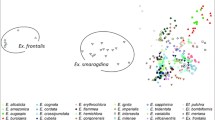Abstract
Cuticular lipid profiles have been shown to be species specific within many insect genera, allowing a chemotaxonomic classification of individuals. In this study, we analysed the cuticular lipids of the orchid bees Euglossa viridissima Friese and Euglossa dilemma Bembé & Eltz, cryptic sibling species whose taxonomic status has only recently been clarified. Male individuals of both species were obtained from two locations on the Yucatán Peninsula, Mexico, both in the dry and wet seasons. Their hydrocarbon profiles proved to be species specific, irrespective of location and season. They also allowed a correct assignment of a rare morph of E. viridissima which had long obscured the distinction of the two species. Our results suggest that cuticular hydrocarbon profiles may be suited for chemical taxonomy of orchid bees and might provide an additional clue for difficult species distinctions.


Similar content being viewed by others
References
Adams, R.P. (2001) Identification of essential oil components by gas chromatography/quadrupole mass spectroscopy. Allured Publishing, Carol Stream
Bagnères, A.G., Wicker-Thomas, C. (2010) Chemical taxonomy with hydrocarbons. In: Blomquist, G.J., Bagnères, A.G. (eds.) Insect Hydrocarbons. Biology, Biochemistry and Chemical Ecology, pp. 121–162. Cambridge University Press, Cambridge
Blomquist, G.J., Bagnères, A.G. (2010) Insect hydrocarbons. Biology, biochemistry, and chemical ecology. Cambridge University Press, Cambridge
Buczkowski, G., Kumar, R., Suib, S.L., Silverman, J. (2005) Diet-related modification of cuticular hydrocarbon profiles of the argentine ant, Linepithema humile, diminishes intercolony aggression. J. Chem. Ecol. 31(4), 829–843
Carlson, D.A., Roan, C.-S., Yost, R.A., Hector, J. (1989) Dimethyl disulfide derivatives of long chain alkenes, alkadienes, and alkatrienes for gas chromatography/mass spectrometry. Anal. Chem. 61, 1564–1571
Clarke, K.R. (1993) Non-parametric multivariate analyses of changes in community structure. Aust. J. Ecol. 18, 117–143
Clarke, K.R., Gorley, R.N. (2006) PRIMER v6: user manual/tutorial. PRIMER-E, Plymouth
Dapporto, L. (2007) Cuticular lipid diversification in Lasiommata megera and Lasiommata paramegaera: the influence of species, sex and population (Lepidoptera: Nymphalidae). Biol. J. Linn. Soc. 91, 703–710
Dressler, R.L. (1982) Biology of the orchid bees (Euglossini). Ann. Rev. Ecol. Syst. 13, 373–394
Eltz, T., Roubik, D.W., Lunau, K. (2005) Experience-dependent choices ensure species-specific fragrance accumulation in male orchid bees. Behav. Ecol. Sociobiol. 59, 149–156
Eltz, T., Zimmermann, Y., Haftmann, J., Twele, R., Francke, W., Quezada-Euan, J.J.G., Lunau, K. (2007) Enfleurage, lipid recycling and the origin of perfume collection in orchid bees. Proc. R. Soc. B 274, 2843–2848
Eltz, T., Zimmermann, Y., Pfeiffer, C., Ramirez-Pech, J., Twele, R., Francke, W., Quezada-Euan, J.J.G., Lunau, K. (2008) An olfactory shift is associated with male perfume differentiation and species divergence in orchid bees. Curr. Biol. 18, 1844–1848
Eltz, T., Fritzsch, F., Ramirez-Pech, J., Zimmermann, Y., Quezada-Euan, J.J.G., Ramírez, S.R., Bembé, B. (2011) Characterization of the orchid bee Euglossa viridissima (Apidae: Euglossini) and a novel cryptic sibling species, by morphological, chemical, and genetic characters. Zool. J. Linn. Soc. 163, 1064–1076
Howard, R.W. (1993) Cuticular hydrocarbons and chemical communication. In: Stanley-Samuelson, D.W., Nelson, D.R. (eds.) Insect Lipids: Chemistry, Biochemistry and Biology, pp. 179–226. University of Nebraska Press, Lincoln
Howard, R.W., Blomquist, G.J. (2005) Ecological, behavioural, and biochemical aspects of insect hydrocarbons. Annu. Rev. Entomol. 50, 371–393
Kather, R., Martin, S.J. (2012) Cuticular hydrocarbon profiles as a taxonomic tool: advantages, limitations and technical aspects. Physiol. Entomol. 37, 25–32
Liang, D., Silverman, J. (2000) “You are what you eat”: diet modifies cuticular hydrocarbons and nestmate recognition in the Argentine ant, Linepithema humile. Naturwissenschaften 87, 412–416
Liu, Z.B., Bagnères, A.G., Yamane, S., Wang, Q.C., Kojima, J. (2001) Intra-colony, inter-colony and seasonal variations of cuticular hydrocarbon profiles in Formica japonica (Hymenoptera, Formicidae). Insect. Soc. 48, 342–346
Martin, S.J., Shemilt, S., Drijfhout, F.P. (2012) Effect of time on colony odour stability in the ant Formica exsecta. Naturwissenschaften 99, 327–331
Roubik, D.W., Hanson, P.E. (2004) Orchid bees of tropical America. Instituto Nacional de Biodiversidad (INBio), Heredia
Seppä, P., Helanterä, H., Trontti, K., Punttila, P., Chernenko, A., Martin, S.J., Sundström, L. (2011) The many ways to delimit species: hairs, genes and surface chemistry. Myrmecol. News 15, 31–41
Zimmermann, Y., Ramírez, S.R., Eltz, T. (2009) Chemical niche differentiation among sympatric species of orchid bees. Ecology 90(11), 2994–3008
Acknowledgments
Marko Hannibal and Jorge Ramirez Pech helped with sample collection. This work was supported by the Deutscher Akademischer Austausch Dienst PROALMEX programme and the Deutsche Forschungsgemeinschaft (El 249/6). Two anonymous reviewers helped to improve an earlier version of this manuscript.
Author information
Authors and Affiliations
Corresponding author
Additional information
Manuscript editor: Klaus Hartfelder
Les hydrocarbures cuticulaires permettent de distinguer les espèces jumelles cryptiques chez les abeilles à orchidée du genre Euglossa
hydrocarbures cuticulaires / Apidae / Euglossa / chimiosystématique / abeilles à orchidée
Unterscheidung zwischen kryptischen Schwesterarten von Prachtbienen ( Euglossa ) anhand kutikulärer Kohlenwasserstoffe
kutikuläre Kohlenwasserstoffe / Apidae / Euglossa / Prachtbiene / Chemotaxonomie
Rights and permissions
About this article
Cite this article
Pokorny, T., Lunau, K., Quezada-Euan, J.J.G. et al. Cuticular hydrocarbons distinguish cryptic sibling species in Euglossa orchid bees. Apidologie 45, 276–283 (2014). https://doi.org/10.1007/s13592-013-0250-5
Received:
Revised:
Accepted:
Published:
Issue Date:
DOI: https://doi.org/10.1007/s13592-013-0250-5




